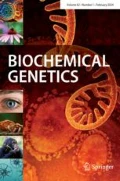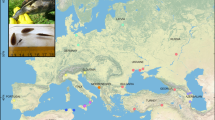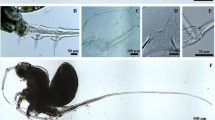Abstract
In this study the genetic diversity of local freshwater leeches (Hirudinaria spp.) was inferred using mtDNA COI gene analysis and compared with the gross external variations of 26 freshwater leech specimens obtained from the wild and leech farms. Based on a neighbor-joining tree generated from 516 COI base sequences, four distinct clades of Hirudinaria were seen with interspecific genetic divergence in the range of 7.6–14.5%. The external morphological variations based on the presence of stripes, location of gonopores, and anus separated the samples into four morphologically distinct groups matching the four clades obtained from the molecular data. Two black stripes at the ventral region were observed only in specimens found clustered with clades that contained the GenBank-reported H. manillensis, whereas the brown or dark green coloration without stripes on the ventral region was seen in samples that clustered with H. javanica and H. bpling clades.



Similar content being viewed by others
References
Bickel KD, Lineaweaver WC, Follansbee S, Feibel R, Jackson R, Buncke HJ (1994) Intestinal flora of the medicinal leech Hirudinaria manillensis. J Reconstr Microsurg 10(2):83–85
Borda E, Siddall ME (2004) Arhynchobdellida (Annelida: Oligochaeta: Hirudinida): phylogenetic relationships and evolution. Mol Phylogenet Evol 30:213–225
Borda E, Oceguera-Figueroa A, Siddall ME (2008) On the classification, evolution and biogeography of terrestrial haemadipsoid leeches (Hirudinida: Arhynchobdellida: Hirudiniformes). Mol Phylogenet Evol 46(1):142–154
Electricwala A, Sawyer RT, Jones CP, Atkinson T (1991) Isolation of thrombin inhibitor from the leech Hirudinaria manillensis. Blood Coagul Fibrin 2(1):83–89
Elliott JM, Kutschera U (2011) Medicinal leeches: historical use, ecology, genetics and conservation. Freshw Rev 4:21–41
Folmer O, Black M, Hoeh W, Lutz R, Vrijenhoek R (1994) DNA primers for amplification of mitochondrial cytochrome c oxidase subunit I from diverse metazoan invertebrates. Mol Mar Biol Biotech 3:294–299
Kutschera U, Roth M (2006) Notes on the ecology of the Asian medicinal leech Hirudinaria manillensis (Hirudinea: Hirudinidae). Lauterbornia 56:9–13
Lai YT, Chen JH (2010) Leech fauna of Taiwan. National Taiwan University Press pp 48–59
Moore JP (1938) Leeches (Hirudinea) principally from the Malay Peninsular, with descriptions of new species. Bull Raffles Mus 14:64–80
Nesemann H, Sharma S (2001) Leeches of the suborder Hirudiniformes (Hirudinea: Haemopidae, Hirudinidae, Haemadipsidae) from the Ganga watershed (Nepal, India: Bihar). Annalen des Naturhistorischen Museums in Wien 103:77–88
Phillips AJ (2012) Phylogenetic placement of a new species of Asian buffalo leech (Arhynchobdellida: Hirudinidae), and confirmation of human-mediated dispersal of a congener to the Caribbean. Invertebr Syst 26:293–302
Phillips AJ, Siddall ME (2009) Poly-paraphyly of Hirudinidae: many lineages of medicinal leeches. BMC Evol Biol 9:246–257
Posada D (2008) jModelTest: phylogenetic model averaging. Mol Biol Evol 25:1253–1256
Siddall ME, Trontelj P, Utevsky SY, Nkamany M, Macdonald KS III (2007) Diverse molecular data demonstrate that commercially available medicinal leeches are not Hirudo medicinalis. Proc R Soc B 274:1481–1487
Sket B, Trontelj P (2008) Global diversity of leeches (Hirudinea) in freshwater. Hydrobiologia 595:129–137
Swofford DL (2002) PAUP: phylogenetic analysis using parsimony (and other methods), version 4. Sinauer Associates, Sunderland, Mass
Tamura K, Dudley J, Nei M, Kumar S (2007) Mega4: molecular evolutionary genetics analysis software, version 4.0. Mol Biol Evol 24:1596–1599
Tan E (2008) Progress in the study of ecology, zoogrography, group, control repellent and medical usage of Hirudinea in China. Acta Ecol Sin 28(12):6272–6281
Teh JC, Kamarudin MS, Rahim AA, Saad CR (2011) Performance of selected chemical compounds in eliciting feeding of Asian buffalo leech, Hirudinaria manillensis. J Fish Aquat Sci 6(7):846–851
Trontelj P, Utevsky SY (2005) Celebrity with a neglected taxonomy: molecular systematic of the medicinal leech (genus Hirudo). Mol Phylogenet Evol 34:616–624
Whitman CO (1886) The leeches of Japan. Q J Microsc Sci 26:317–416
Zaidi SM, Jameel SS, Zaman F, Jilani S, Sultana A, Khan SA (2011) A systematic overview of the medicinal importance of sanguivorous leeches. Altern Med Rev 16(1):59–65
Zhang BLQ, Lin JL, Chu X, Lu J (2008) Effects of broodstock density and diet on reproduction and juvenile culture of the leech, Hirudinaria manillensis Lesson, 1842. Aquaculture 276:198–204
Acknowledgments
This study was supported by the Fundamental Research Grant Scheme (FRGS/1/10/NSNH/MUST/02/1) under the Ministry of Higher Education (MOHE). The authors would also like to express their gratitude to Mr. Francis King and Mr. Ahmad Izham for providing the samples used in this study.
Author information
Authors and Affiliations
Corresponding author
Rights and permissions
About this article
Cite this article
Chong, L.K., Ong, A.H.K., Tan, S.G. et al. Morphological and Genetic Variations of the Freshwater Leech, Hirudinaria spp., in Peninsular Malaysia. Biochem Genet 52, 283–295 (2014). https://doi.org/10.1007/s10528-014-9647-8
Received:
Accepted:
Published:
Issue Date:
DOI: https://doi.org/10.1007/s10528-014-9647-8




